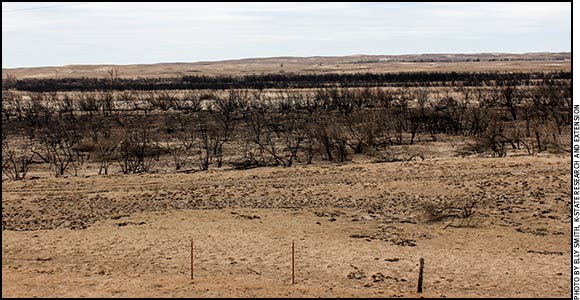
Moisture, Higher Temps Critical for SW Kansas Grasslands
Reducing stocking rate may also be an option for some cattlemen.
A Kansas State University (K-State) expert says the region’s grasslands will need some moisture and higher temperatures to recover from wildfires that scorched an estimated 1 million acres in Colorado, Kansas, Oklahoma and Texas last week.
This weekend’s temperatures may hit the 70s and 80s, but the forecast remains dry for many parts of the four states.
“As these plants start their growing season, they are going to need subsoil moisture to at least get started,” said Walt Fick, range management specialist with K-State Research and Extension.
“From last November through the present, some of those areas had anywhere from 2 to 5 inches of moisture,” Fick said. “That’s not too bad; there might be enough moisture to start. But a lot of those grasslands’ recovery is going to depend on subsequent moisture.”
Grass species in heavier-textured soils — such as buffalograss, blue grama and western wheat grass — can be susceptible to damage from fire this time of year. Fick said studies have indicated that these types of grasses can suffer a 65% reduction of forage the first year, and 39% the following year.
After a previous year’s fire, “it took most of two to three years for grasses to recover on that type of soil,” he said.
Rhizome species such as sand bluestem, Indiangrass and switchgrass tend not to be harmed much by fire. “At this point in time, the rhizome is well below ground,” Fick said. “Assuming we have some soil moisture and rain to get them growing again, I think they’ll recover quite nicely.”
In areas where little bluestem is found, Fick said he has some concern because it’s a bunchgrass, which has its growing point at the crown (the soil surface), where fire can do more damage.
Once grasses begin growing back, Fick said he would suggest holding off on putting cattle out to graze “to give those plants a chance to recover a little and start growing.”
“In those heavier soils, I would suspect some reduction of stocking rate may be necessary, maybe 25% or more the first year,” he said. “Because grass in sandy soils is a different plant community, it may not be hurt as much. I suspect they’ll recover quicker because of the types of grass species that are on them.
“Taking a conservative approach is always a good idea. I think a lot depends on how it has been managed prior [to the fire]. If it had been abused and grazed heavily for a number of years, well, they’re going to be slower to recover. If the pastures have been managed well and you have a good composition, I think they’ll bounce back quickly.”
Fick noted that the early part of the growing season is critical.
“We are going to have some critical dates that we need to watch and make decisions,” he said. “If the grassland is not recovering like we think it should, then maybe we ought to cut back or do some de-stocking.”

Editor’s Note: This article was provided by K-State Research and Extension.






